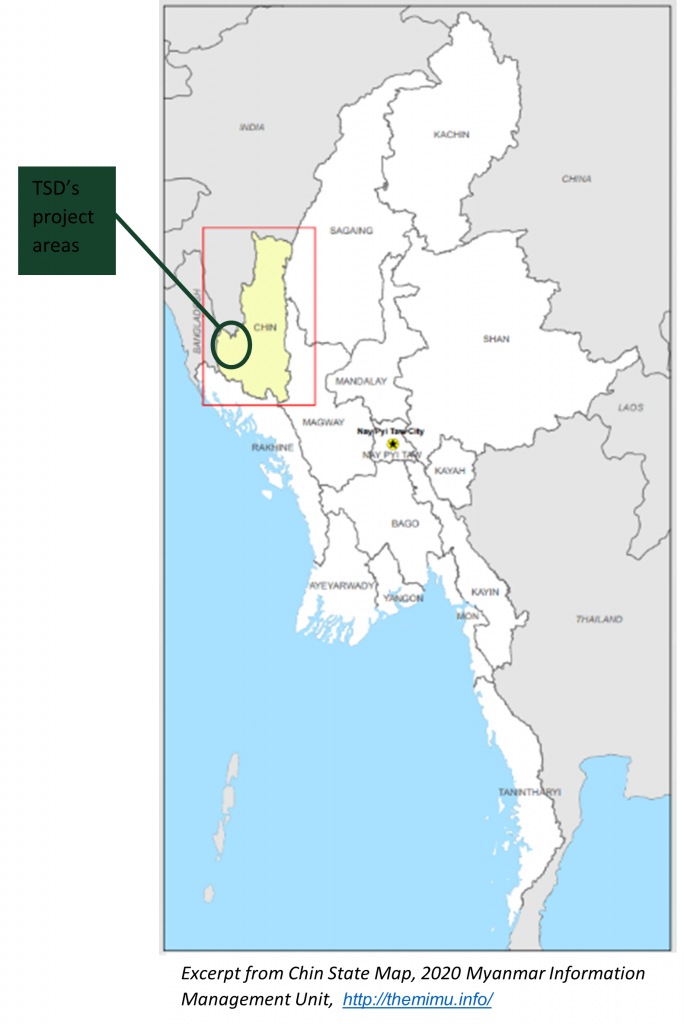Where We Work
TSD is based in a remote area of Chin State, Myanmar (Burma), in the region inhabited by the Mara population – one of Myanmar’s many ethnic minorities. The organisation has past or current projects in many of the 53 Mara communities in this area and plans to expand to serve other parts of southern Chin State.
Chin State is a beautiful mountainous region with several natural resources, including forest products, waterways, and minerals. However, it is a challenging topography for agriculture and there is little transport or communication infrastructure, making most communities very isolated, especially in southern Chin State where TSD works. Most of the region is forest/jungle, but with serious environmental issues related to uncontrolled ‘slash-and-burn’ agricultural methods and hunting of wildlife.
Chin State’s source of beauty is also a source of hardship and isolation. The mountainous terrain poses a challenge for farming, makes road construction difficult, and provides the threat of frequent landslides.
With few roads, much transport in southern Chin State takes place by motorbike on narrow mountain paths – for those who can afford it. Others walk for days on foot to access services such as healthcare, markets, or school examinations.
The state’s sparse population of approximately 479,000 people mostly live in small rural villages. Largely isolated from the rest of Myanmar, people in southern Chin State are almost exclusively subsistence farmers, traditionally producing rice as their staple food using ‘shifting cultivation’ (or ‘slash-and-burn’). The Chin population is composed of many different ethnic tribes. Most are Christian, with a minority Buddhist and Animist. Generally, the church plays a significant social role in Chin society, influencing many aspects of daily life. Their shared faith contributes to a strong sense of social cohesion, a commitment to community service, and hope in the face of adversity – all key assets that have helped Chin communities endure past suffering and remain hopeful for the future.
Many families struggle to meet basic needs and have few options to cope when faced with shocks. Yet the strong sense of social cohesion and perseverance in many Chin communities bolsters their resilience.
Approximately 98% of people are subsistence farmers in southern Chin State, fully reliant on the land to provide for their needs.
Chin State is one of the least developed states in Myanmar, with deficiencies in most sectors. The state has the highest poverty rates in Myanmar, with the lowest GDP per capita, 58% of the population living below the poverty line and 24.5% considered insecure as they live close to the poverty line (UNDP, World Bank & Myanmar Central Statistical Organization). Food insecurity is a chronic problem in much of Chin State which has the highest rates of child malnutrition in the country: with 40.3% of children suffering from stunting (Ministry of Health & Sports). In southern Chin State, WFP estimates that only 15.3% of the population has an adequate diet. Making matters worse, this region and its agriculture-dependent population are considered particularly vulnerable to climate change impacts.
Education outcomes are also particularly poor in Chin State, with many children dropping out of school early. For those who make it through to high school, Chin State often has the highest rate of failure for the final matriculation exams with over 80% typically failing. The current education system in Myanmar excludes or disadvantages many children due to ethnicity, geographical location, language, religion, and poverty. For those children who can access education, outdated curriculum content, ineffective teaching methods and the lack of skilled and educated local leaders often stand in the way of their success. The lack of educational investment has fed into a cycle of poverty and hopelessness that is seen across Myanmar.
Overall, rural communities in Chin State face numerous challenges. Although the population has developed resilience through years of struggle, they have few opportunities to access services, opportunities, or resources to overcome these hardships. In response, TSD’s sustainable development programs focus on bringing social and economic transformation into the lives of individuals in these remote rural communities.

